Verdict
An outdoor speaker with a rich, lively sound and stylish looks; if you can cope with its size and heft the Marshall Middleton is an enjoyable portable speaker, though it’s pricey for what it offers.
Pros
- Rich, lively presentation
- Rugged build quality
- Great, stylish looks
Cons
- Expensive
- Beaten for clarity and detail
- Big and heavy
-
Water and dust protectionProtected against dust, and submersible into water 1m deep -
Power bankPlug a mobile device into the USB-C port and charge it -
True Stereophonic soundOutputs sound from every angle
Introduction
With the Middleton, Marshall’s line-up of outdoor speakers appears complete with this speaker – as the name implies – slotting somewhere in the middle of the range.
There’s now a choice of the Willen, Emberton II, Kliburn II, Stockwell II, Middleton, and if you wanted to go bigger, though not as portable, the Tufton Bluetooth speaker. That’s a bevy of options from small to large to take your tunes from out the house to the great outdoors.
The ‘middle’ child is often the one that needs to compete for attention. It’s certainly one of the biggest in Marshall’s portable speaker range, but does it have the chops to be the best? Here are my thoughts.
Design
- Strap for carry
- Big and heavy design
- Protected against dust and liquids
Visually, the Marshall Middleton takes the appearance of the Emberton II’s bigger brother. I described the Emberton as the size of a bar of butter, while the Middleton is very much a brick.
If the Emberton series could be taken to the park, beach, or even tucked into luggage to be taken overseas, the Middleton’s size makes it less versatile. The places you’d likely take it are closer to home unless it’s going in the backseat of a car for a road trip.
With dimensions of 109 x 230 x 95mm (HWD) and a weight of 1.8kg, the Middleton is a big speaker to hold in one hand, bigger than the comparable JBL Charge 5. In its favour is that it comes with a carry strap that can be fastened via a neat clasp and that does serve to make it feel less heavy when carrying it about.
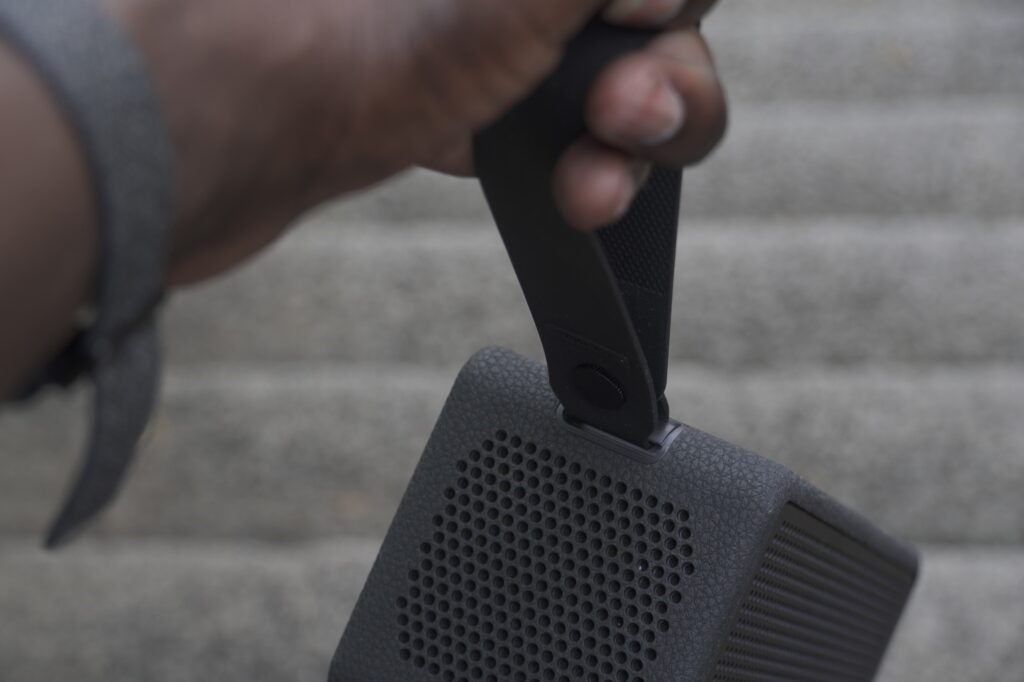
It’s once again a distinctive looking effort, the black and brass finish of the sample I have is an option along with a cream finish.
As is common with most of Marshall’s wireless speakers and headphones, there’s the gold finished multi-directional, multi-function knob for powering the speaker on and off, adjusting volume and wiggling left or right to skip tracks. If you’re not used to it, it can be fiddly at first but becomes relatively easy to operate by giving it a nudge.
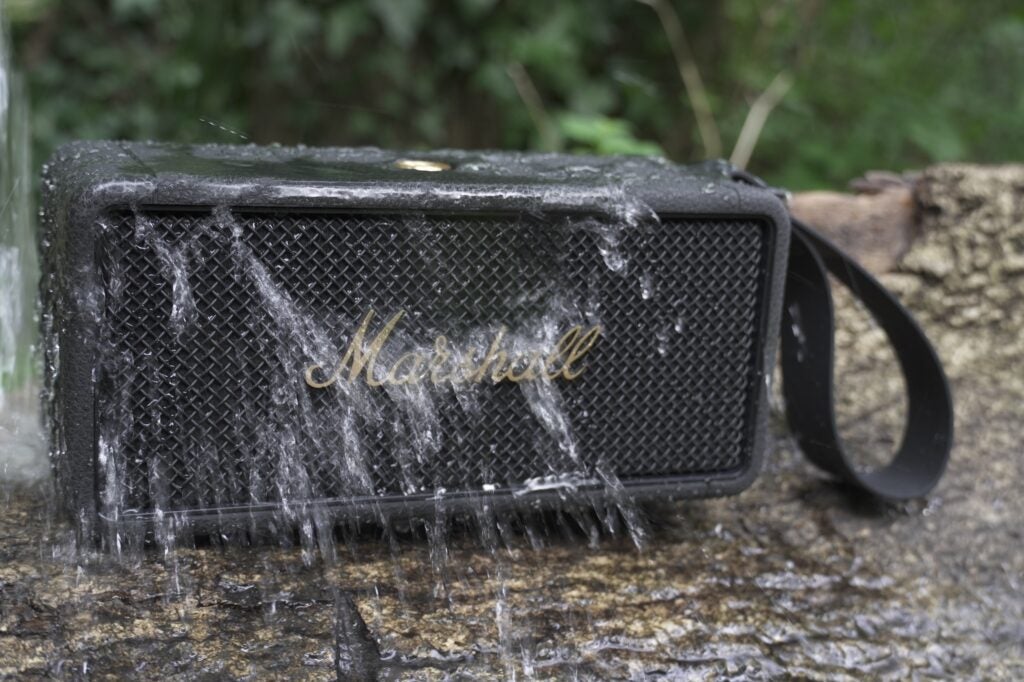
It carries an IP67 rating that provides complete protection against the ingress of dust along with protection against liquids, including submersion into water up to 1m deep.
The exposed 3.5mm and USB-C ports on the rear give me a little pause for thought as to whether you’d want to completely dunk this speaker into a body of water. There’s no tab provided in the speaker’s accessories to cover it up.
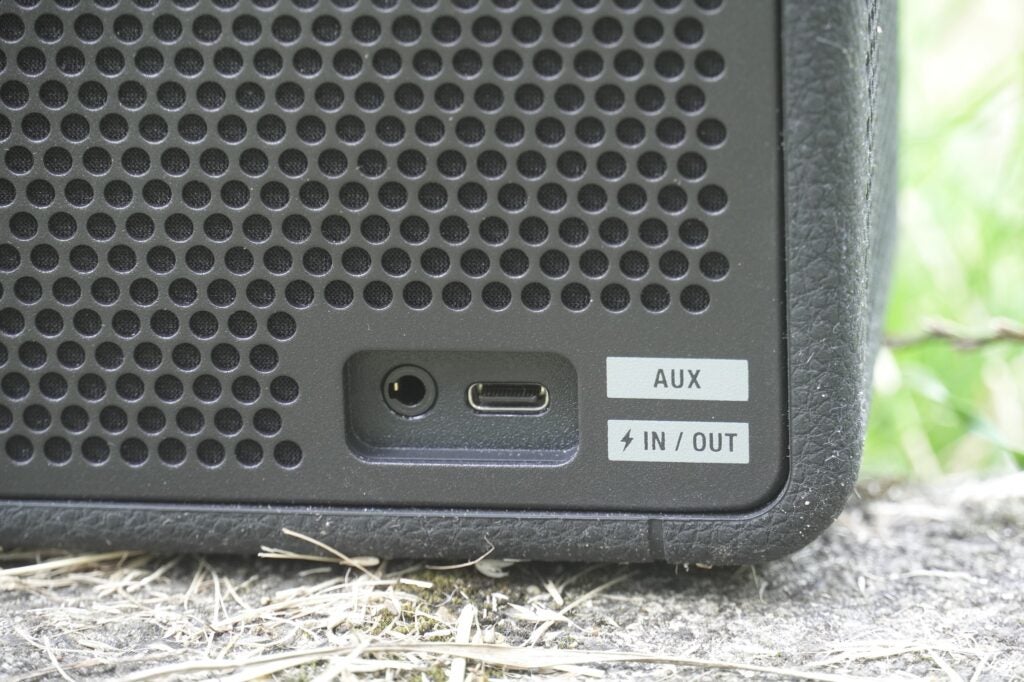
On the top surface there’s a Bluetooth button, a battery/volume level indicator, and bass and treble controls to adjust the audio performance. The Middleton is a solid-feeling speaker, sturdy and tough in a way that gives the impression of being unbreakable.
Like the Emberton II, Marshall says the construction of the speaker comprises of 55% post-consumer recycled plastic from used electronics, automotive light covers, and water bottles. They also state that the speaker is 100% free from PVC plastics.
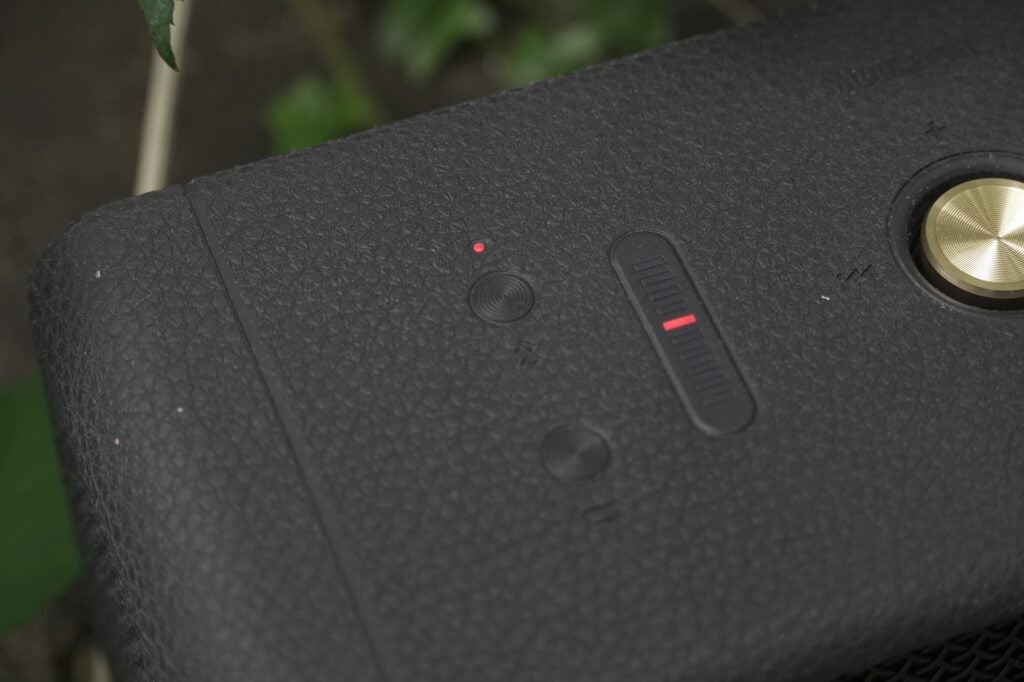
Features
- SBC Bluetooth audio
- True Stereophonic soundstage
- Compatible with Marshall Bluetooth app
Marshall states that battery life is about 20+ hours, less than the Emberton II and around the same as the Stockwell II. The app only registers 10% drops, so it’s tricky to gauge just how exact the battery life is lost
Streaming from Spotify and Amazon Music at 50% volume registered somewhere in the region of a 15-20% drop over a 90-minute period. 20+ hours doesn’t seem possible unless at lower volumes.
The Middleton does have a trick up its sleeve as it can act as a power bank to charge a mobile device through its USB-C port. Fast-charging is available with a 20-minute top up providing two more hours of playback.
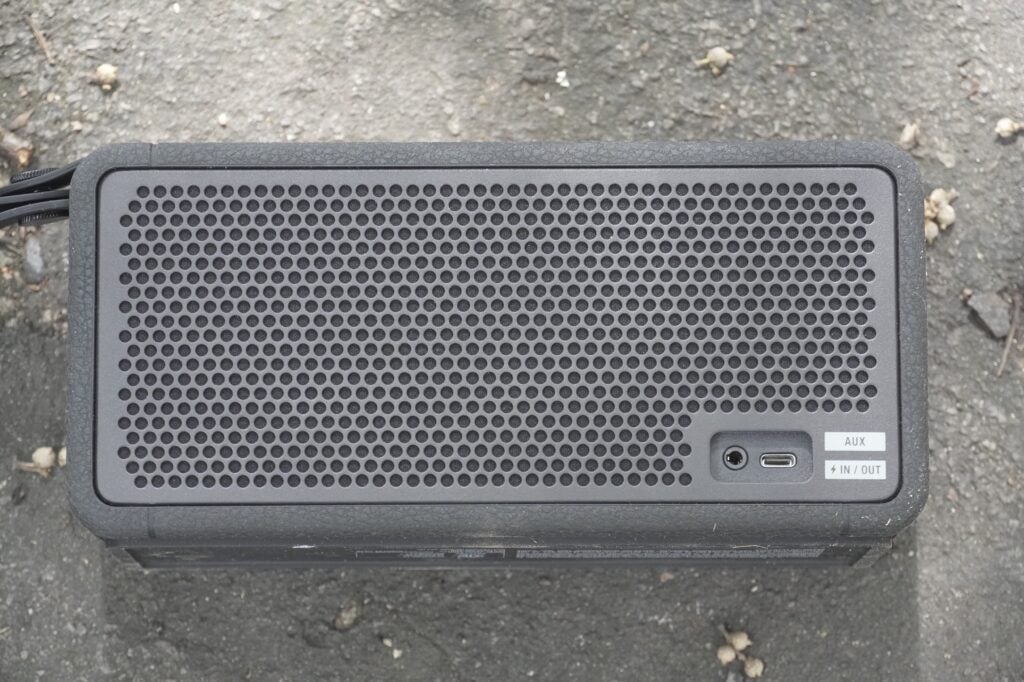
Bluetooth support equates to v5.1 but surprisingly only the SBC codec is available for streaming audio, which is the lowest quality available. You shouldn’t necessarily fear for the audio performance, however, as the quality of the speakers themselves will have the greatest effect.
The stability of the wireless connection is excellent, with no breakup or stutter when I placed the speaker at one end of my garden and walked away to the other end, which was more than twenty metres from the speaker.
The Middleton is also capable of hitting an impressively loud volume without distortion or shirking on clarity and detail. This is probably down to its built-in Dynamic Loudness function that claims to adjust the speaker’s output at every volume level.
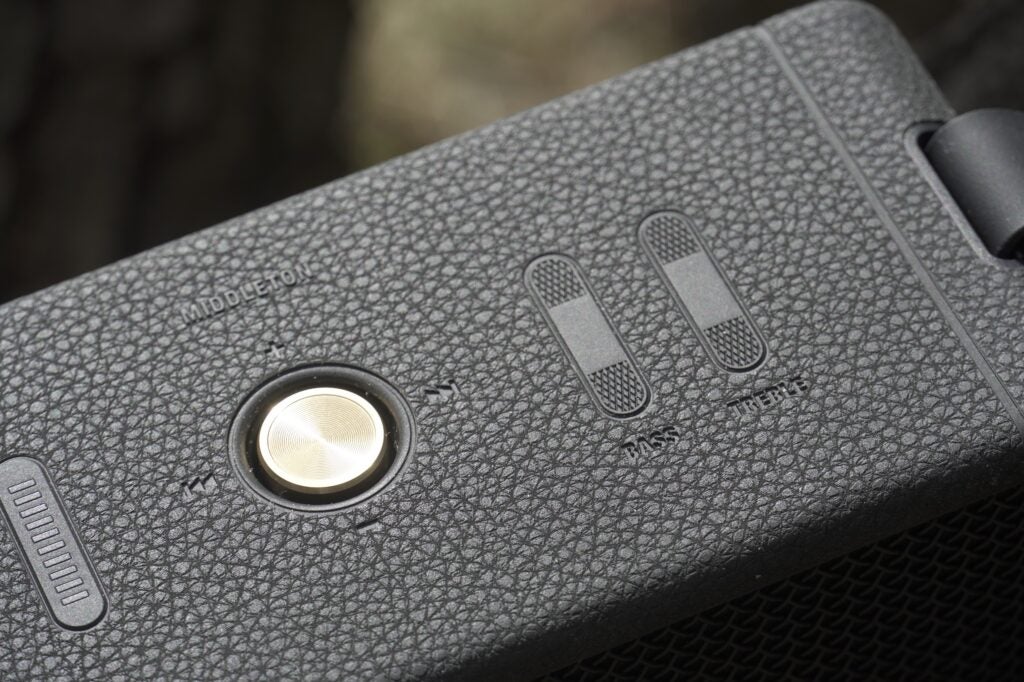
Then there is Marshall’s True Stereophonic feature, which it describes as “multi-directional stereo sound”. What that means is that you get a consistent performance from whichever direction you’re facing the speaker – the perforations on its side are a clue as to how that sound is emitted from the Middleton.
I find it works well, the sound from the front and back is consistent, and there’s not a huge downshift listening from the sides, although facing its front or back offers the best sound.
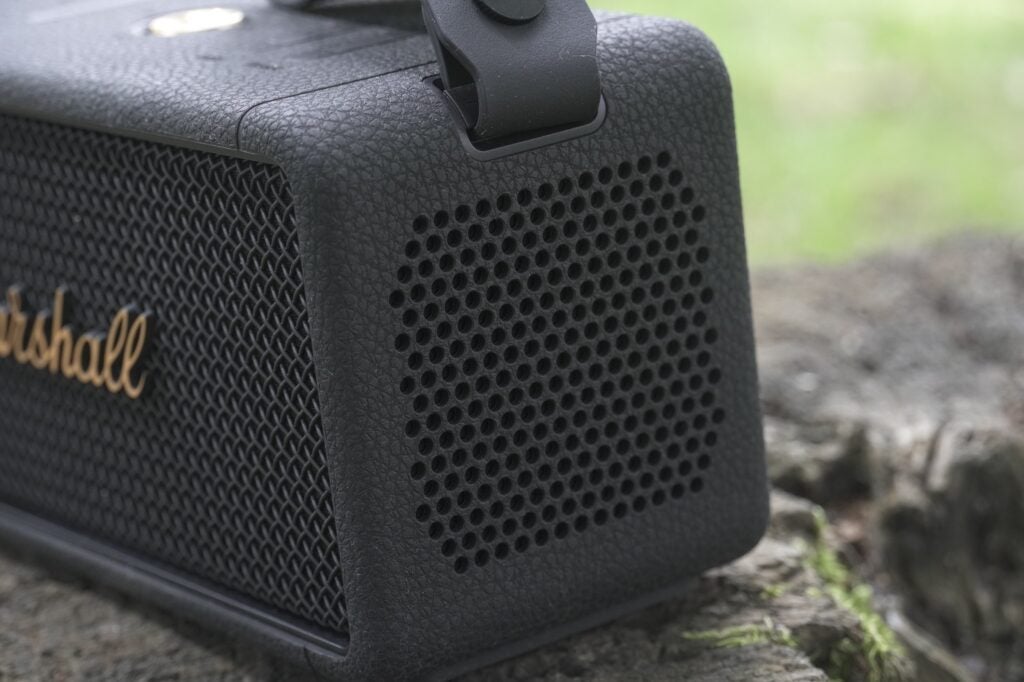
The Middleton supports the Marshall Bluetooth app, but features are sparse. There’s the Stack Mode where multiple Middleton speakers can be connected, EQ tuning for treble and bass (from -5 to +5), battery life indicator and playback controls but that’s it. It’s simple to use but aside from the Stack Mode the rest can be done via onboard controls.
Sound Quality
- Rich, lively audio
- Weighty bass and bright treble
- Beaten for clarity
Like the Emberton II, the Middleton is a rich-sounding speaker with big bass and surprisingly bright treble performance, taking on what sounds to be a V-shaped tuning with regards to the frequency range.
There are obvious benefits from the jump in size to the larger speaker. The scale and size of the soundstage is enlarged on the Middleton and that provides more room for instruments that on the Emberton II would be on the fringes of the soundstage.
There’s improved separation of vocals and low frequencies so they aren’t always competing for attention, and that also allows more space for vocals to exist and be projected from the speaker. Playing Siouxsie and the Banshees’ Face to Face and Snoop Dogg/Pharell’s Beautiful, there’s more room for vocals to be expressed.
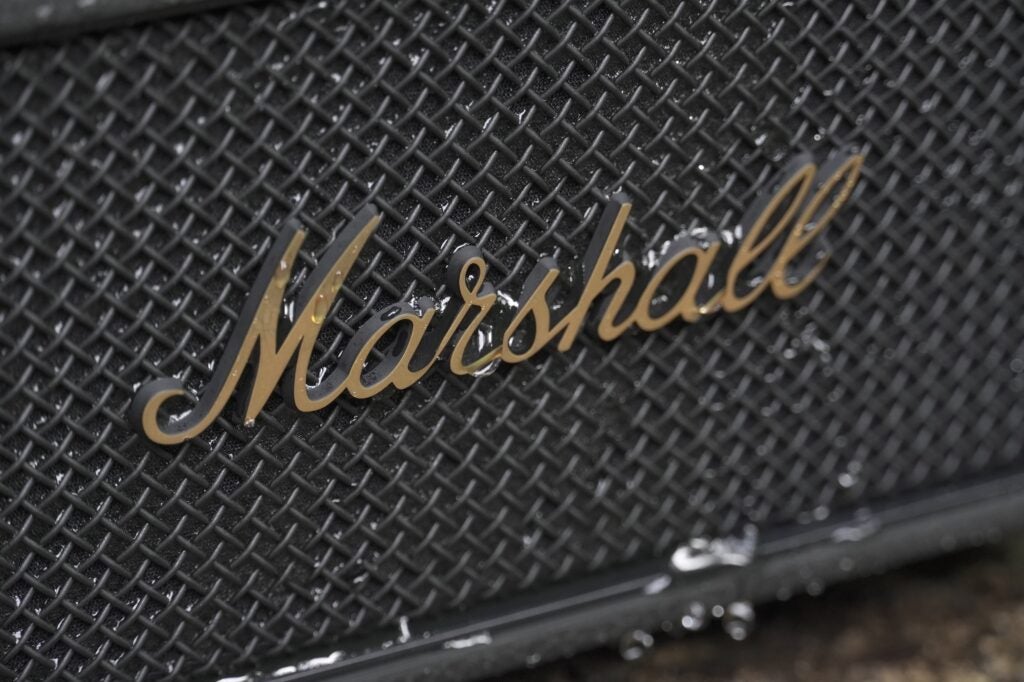
Those vocals are described with clarity and smoothness, though levels of midrange detail and definition aren’t the sharpest or clearest with a Spotify stream. The Middleton doesn’t sound as ‘hi-fi’ as the Bang Olufsen Beosound A1 2nd Gen – but its energetic, and at times dynamic, sound carries welcome appeal.
With bass-heavy tracks like Room 5’s Make Luv and Jodeci’s Feenin’ there’s good depth and weight to the low frequencies, but even with less bassy tracks (Michael Jackson’s Leave Me Alone) I hear a slightly thicker sound signature. I found that taking the bass down by -3 still allowed for strong, punchy bass output but with a little more clarity to the midrange.
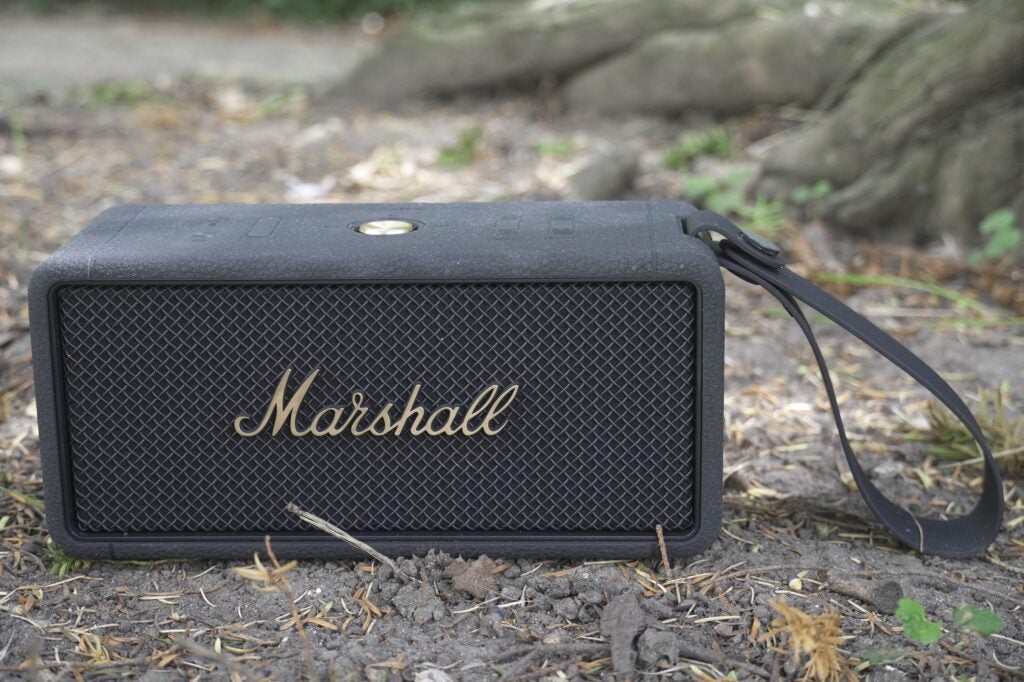
Bass falls away somewhat in outdoor environments, but that applies to virtually all portable speakers in an open space without walls to reflect and reinforce the sound. Bass output is still strong and weighty, and there’s always the option of increasing bass through the EQ settings.
With an Ultra HD stream of Faye Webster’s Better Distractions from Amazon Music and the percussion is punchy and weighty, cymbal crashes have decently crisp tone, and the high frequencies are reproduced brightly. With Lily Allen’s The Fear there’s that warm, punchy bass present again, the track’s dynamic range is conveyed solidly, and the speaker captures the song’s bouncy, propulsive sense of energy.
It’s a more assertive, warmer presentation than the clarity of the Stockwell II affords to the same tracks, and it has a bigger impact at either end of the frequency range. For some, the Middleton’s fun approach to audio may be the clincher.
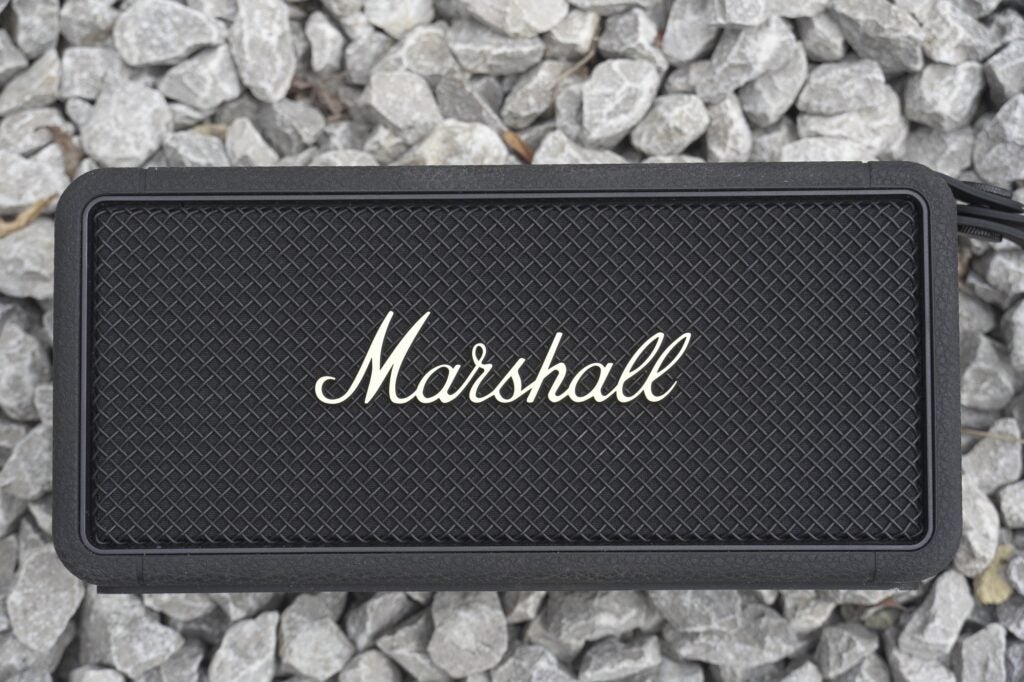
Latest deals
Should you buy it?
If you like a lively, warm presentation: Weighty bass, bright treble, clear and smooth vocals; the Middleton’s sound is one for casual, mainstream listeners.
Final Thoughts
The Marshall Middleton is, effectively, a bigger version of the Emberton II. Similar looks, a richer, more lively sound, if you find the Emberton too small for parties and outdoor gatherings, the Middleton fulfils that role.
Price is a factor, and at £269/$299 it’s a considerable leap above the rest of Marshall’s portable speaker range with only the Kilburn II and Tufton incurring more expense.
And it’s also up against an influx of portable speakers that offer both Bluetooth and Wi-Fi connectivity in the (smaller) Sonos Roam and JBL Charge 5 Wi-Fi. Both these are either cheaper, or around the same price, and as fun as the Middleton sounds, there are speakers such as B&O Beosound A1 2nd Gen that deliver better audio quality and cost less.
So the Marshall Middleton isn’t short of competition, and its size counts against it if you’re after a truly portable speaker. Portable speakers with Bluetooth and Wi-Fi carry more versatility, while the Middleton is a more straightforward portable speaker.
Nevertheless, the Marshall Middleton is a likeable speaker with a fun, lively sound, and one that sounds better if you give it good quality audio. But as a middle child, I’m not sure it’s quite as sure of its place within the family unit.
How we test
We test every wireless speaker we review thoroughly over an extended period of time. We use industry standard tests to compare features properly. We’ll always tell you what we find. We never, ever, accept money to review a product.
Find out more about how we test in our ethics policy.
Tested with real world use
FAQs
The Middleton only supports SBC Bluetooth, which is the same as the Emberton II speaker. The Stockwell II supports Bluetooth codecs up to aptX.
Verdict
An outdoor speaker with a rich, lively sound and stylish looks; if you can cope with its size and heft the Marshall Middleton is an enjoyable portable speaker, though it’s pricey for what it offers.
Pros
- Rich, lively presentation
- Rugged build quality
- Great, stylish looks
Cons
- Expensive
- Beaten for clarity and detail
- Big and heavy
-
Water and dust protectionProtected against dust, and submersible into water 1m deep -
Power bankPlug a mobile device into the USB-C port and charge it -
True Stereophonic soundOutputs sound from every angle
Introduction
With the Middleton, Marshall’s line-up of outdoor speakers appears complete with this speaker – as the name implies – slotting somewhere in the middle of the range.
There’s now a choice of the Willen, Emberton II, Kliburn II, Stockwell II, Middleton, and if you wanted to go bigger, though not as portable, the Tufton Bluetooth speaker. That’s a bevy of options from small to large to take your tunes from out the house to the great outdoors.
The ‘middle’ child is often the one that needs to compete for attention. It’s certainly one of the biggest in Marshall’s portable speaker range, but does it have the chops to be the best? Here are my thoughts.
Design
- Strap for carry
- Big and heavy design
- Protected against dust and liquids
Visually, the Marshall Middleton takes the appearance of the Emberton II’s bigger brother. I described the Emberton as the size of a bar of butter, while the Middleton is very much a brick.
If the Emberton series could be taken to the park, beach, or even tucked into luggage to be taken overseas, the Middleton’s size makes it less versatile. The places you’d likely take it are closer to home unless it’s going in the backseat of a car for a road trip.
With dimensions of 109 x 230 x 95mm (HWD) and a weight of 1.8kg, the Middleton is a big speaker to hold in one hand, bigger than the comparable JBL Charge 5. In its favour is that it comes with a carry strap that can be fastened via a neat clasp and that does serve to make it feel less heavy when carrying it about.

It’s once again a distinctive looking effort, the black and brass finish of the sample I have is an option along with a cream finish.
As is common with most of Marshall’s wireless speakers and headphones, there’s the gold finished multi-directional, multi-function knob for powering the speaker on and off, adjusting volume and wiggling left or right to skip tracks. If you’re not used to it, it can be fiddly at first but becomes relatively easy to operate by giving it a nudge.

It carries an IP67 rating that provides complete protection against the ingress of dust along with protection against liquids, including submersion into water up to 1m deep.
The exposed 3.5mm and USB-C ports on the rear give me a little pause for thought as to whether you’d want to completely dunk this speaker into a body of water. There’s no tab provided in the speaker’s accessories to cover it up.

On the top surface there’s a Bluetooth button, a battery/volume level indicator, and bass and treble controls to adjust the audio performance. The Middleton is a solid-feeling speaker, sturdy and tough in a way that gives the impression of being unbreakable.
Like the Emberton II, Marshall says the construction of the speaker comprises of 55% post-consumer recycled plastic from used electronics, automotive light covers, and water bottles. They also state that the speaker is 100% free from PVC plastics.

Features
- SBC Bluetooth audio
- True Stereophonic soundstage
- Compatible with Marshall Bluetooth app
Marshall states that battery life is about 20+ hours, less than the Emberton II and around the same as the Stockwell II. The app only registers 10% drops, so it’s tricky to gauge just how exact the battery life is lost
Streaming from Spotify and Amazon Music at 50% volume registered somewhere in the region of a 15-20% drop over a 90-minute period. 20+ hours doesn’t seem possible unless at lower volumes.
The Middleton does have a trick up its sleeve as it can act as a power bank to charge a mobile device through its USB-C port. Fast-charging is available with a 20-minute top up providing two more hours of playback.

Bluetooth support equates to v5.1 but surprisingly only the SBC codec is available for streaming audio, which is the lowest quality available. You shouldn’t necessarily fear for the audio performance, however, as the quality of the speakers themselves will have the greatest effect.
The stability of the wireless connection is excellent, with no breakup or stutter when I placed the speaker at one end of my garden and walked away to the other end, which was more than twenty metres from the speaker.
The Middleton is also capable of hitting an impressively loud volume without distortion or shirking on clarity and detail. This is probably down to its built-in Dynamic Loudness function that claims to adjust the speaker’s output at every volume level.

Then there is Marshall’s True Stereophonic feature, which it describes as “multi-directional stereo sound”. What that means is that you get a consistent performance from whichever direction you’re facing the speaker – the perforations on its side are a clue as to how that sound is emitted from the Middleton.
I find it works well, the sound from the front and back is consistent, and there’s not a huge downshift listening from the sides, although facing its front or back offers the best sound.

The Middleton supports the Marshall Bluetooth app, but features are sparse. There’s the Stack Mode where multiple Middleton speakers can be connected, EQ tuning for treble and bass (from -5 to +5), battery life indicator and playback controls but that’s it. It’s simple to use but aside from the Stack Mode the rest can be done via onboard controls.
Sound Quality
- Rich, lively audio
- Weighty bass and bright treble
- Beaten for clarity
Like the Emberton II, the Middleton is a rich-sounding speaker with big bass and surprisingly bright treble performance, taking on what sounds to be a V-shaped tuning with regards to the frequency range.
There are obvious benefits from the jump in size to the larger speaker. The scale and size of the soundstage is enlarged on the Middleton and that provides more room for instruments that on the Emberton II would be on the fringes of the soundstage.
There’s improved separation of vocals and low frequencies so they aren’t always competing for attention, and that also allows more space for vocals to exist and be projected from the speaker. Playing Siouxsie and the Banshees’ Face to Face and Snoop Dogg/Pharell’s Beautiful, there’s more room for vocals to be expressed.

Those vocals are described with clarity and smoothness, though levels of midrange detail and definition aren’t the sharpest or clearest with a Spotify stream. The Middleton doesn’t sound as ‘hi-fi’ as the Bang Olufsen Beosound A1 2nd Gen – but its energetic, and at times dynamic, sound carries welcome appeal.
With bass-heavy tracks like Room 5’s Make Luv and Jodeci’s Feenin’ there’s good depth and weight to the low frequencies, but even with less bassy tracks (Michael Jackson’s Leave Me Alone) I hear a slightly thicker sound signature. I found that taking the bass down by -3 still allowed for strong, punchy bass output but with a little more clarity to the midrange.

Bass falls away somewhat in outdoor environments, but that applies to virtually all portable speakers in an open space without walls to reflect and reinforce the sound. Bass output is still strong and weighty, and there’s always the option of increasing bass through the EQ settings.
With an Ultra HD stream of Faye Webster’s Better Distractions from Amazon Music and the percussion is punchy and weighty, cymbal crashes have decently crisp tone, and the high frequencies are reproduced brightly. With Lily Allen’s The Fear there’s that warm, punchy bass present again, the track’s dynamic range is conveyed solidly, and the speaker captures the song’s bouncy, propulsive sense of energy.
It’s a more assertive, warmer presentation than the clarity of the Stockwell II affords to the same tracks, and it has a bigger impact at either end of the frequency range. For some, the Middleton’s fun approach to audio may be the clincher.

Latest deals
Should you buy it?
If you like a lively, warm presentation: Weighty bass, bright treble, clear and smooth vocals; the Middleton’s sound is one for casual, mainstream listeners.
Final Thoughts
The Marshall Middleton is, effectively, a bigger version of the Emberton II. Similar looks, a richer, more lively sound, if you find the Emberton too small for parties and outdoor gatherings, the Middleton fulfils that role.
Price is a factor, and at £269/$299 it’s a considerable leap above the rest of Marshall’s portable speaker range with only the Kilburn II and Tufton incurring more expense.
And it’s also up against an influx of portable speakers that offer both Bluetooth and Wi-Fi connectivity in the (smaller) Sonos Roam and JBL Charge 5 Wi-Fi. Both these are either cheaper, or around the same price, and as fun as the Middleton sounds, there are speakers such as B&O Beosound A1 2nd Gen that deliver better audio quality and cost less.
So the Marshall Middleton isn’t short of competition, and its size counts against it if you’re after a truly portable speaker. Portable speakers with Bluetooth and Wi-Fi carry more versatility, while the Middleton is a more straightforward portable speaker.
Nevertheless, the Marshall Middleton is a likeable speaker with a fun, lively sound, and one that sounds better if you give it good quality audio. But as a middle child, I’m not sure it’s quite as sure of its place within the family unit.
How we test
We test every wireless speaker we review thoroughly over an extended period of time. We use industry standard tests to compare features properly. We’ll always tell you what we find. We never, ever, accept money to review a product.
Find out more about how we test in our ethics policy.
Tested with real world use
FAQs
The Middleton only supports SBC Bluetooth, which is the same as the Emberton II speaker. The Stockwell II supports Bluetooth codecs up to aptX.
























